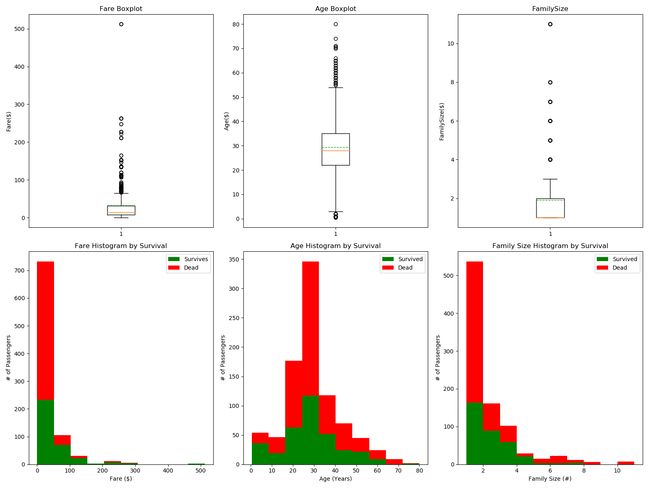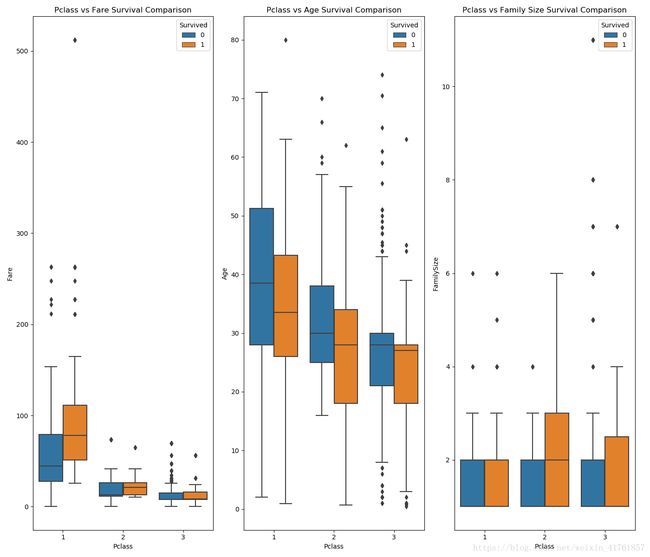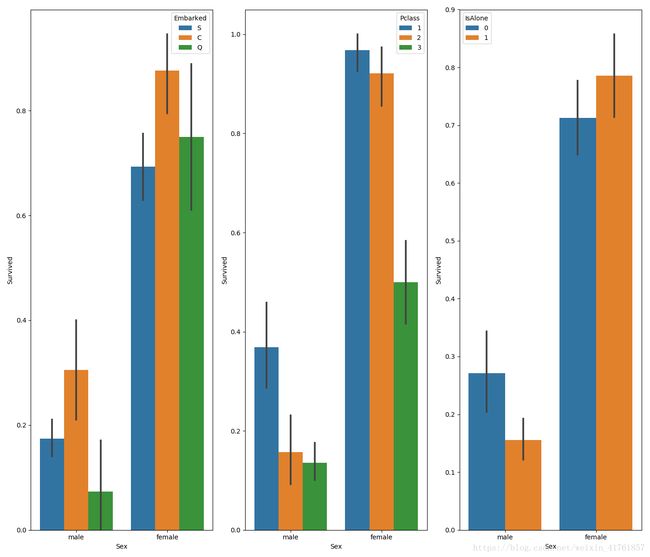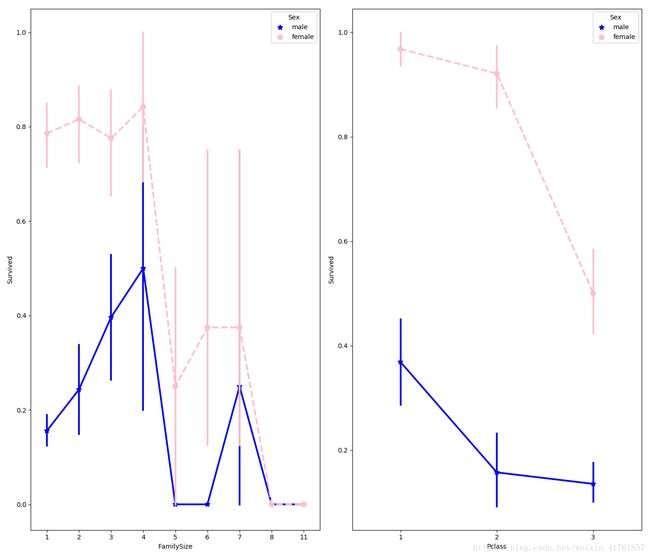数据分析入门--数据科学框架的搭建--04数据的统计性初探
本文基于kaggle入门项目Titanic金牌获得者的Kernel翻译而来,并对其代码进行注解
原文链接https://www.kaggle.com/ldfreeman3/a-data-science-framework-to-achieve-99-accuracy
现在,我们清理好数据。将应用描述性统计与图形统计探索我们的数据与总结我们的变量。在这个阶段,你将对特征进行分类并确定它们与目标变量之间的关系。
#Discrete Variable Correlation by Survival using
#group by aka pivot table: https://pandas.pydata.org/pandas-docs/stable/generated/pandas.DataFrame.groupby.html
for x in data1_x:
if data1[x].dtype != 'float64' :
print('Survival Correlation by:', x)
print(data1[[x, Target[0]]].groupby(x, as_index=False).mean())
print('-'*10, '\n')
#using crosstabs: https://pandas.pydata.org/pandas-docs/stable/generated/pandas.crosstab.html
print(pd.crosstab(data1['Title'],data1[Target[0]]))
结果为:
Survival Correlation by: Sex
Sex Survived
0 female 0.742038
1 male 0.188908
----------
Survival Correlation by: Pclass
Pclass Survived
0 1 0.629630
1 2 0.472826
2 3 0.242363
----------
Survival Correlation by: Embarked
Embarked Survived
0 C 0.553571
1 Q 0.389610
2 S 0.339009
----------
Survival Correlation by: Title
Title Survived
0 Master 0.575000
1 Misc 0.444444
2 Miss 0.697802
3 Mr 0.156673
4 Mrs 0.792000
----------
Survival Correlation by: SibSp
SibSp Survived
0 0 0.345395
1 1 0.535885
2 2 0.464286
3 3 0.250000
4 4 0.166667
5 5 0.000000
6 8 0.000000
----------
Survival Correlation by: Parch
Parch Survived
0 0 0.343658
1 1 0.550847
2 2 0.500000
3 3 0.600000
4 4 0.000000
5 5 0.200000
6 6 0.000000
----------
Survival Correlation by: FamilySize
FamilySize Survived
0 1 0.303538
1 2 0.552795
2 3 0.578431
3 4 0.724138
4 5 0.200000
5 6 0.136364
6 7 0.333333
7 8 0.000000
8 11 0.000000
----------
Survival Correlation by: IsAlone
IsAlone Survived
0 0 0.505650
1 1 0.303538
----------
Survived 0 1
Title
Master 17 23
Misc 15 12
Miss 55 127
Mr 436 81
Mrs 26 99
1.探索各个标签的不同特征值的生存结果对比
import matplotlib.pyplot as plt
plt.figure(figsize = [16,12])
plt.subplot(231)
plt.boxplot(x = data1['Fare'],showmeans = True,meanline = True)
plt.title('Fare Boxplot')
plt.ylabel('Fare($)')
plt.subplot(232)
plt.boxplot(x = data1['Age'], showmeans = True, meanline = True)
plt.title('Age Boxplot')
plt.ylabel('Age($)')
plt.subplot(233)
plt.boxplot(x = data1['FamilySize'],showmeans = True, meanline = True)
plt.title('FamilySize')
plt.ylabel('FamilySize($)')
plt.subplot(234)
plt.hist(x = [data1[data1['Survived']==1]['Fare'],data1[data1['Survived']==0]['Fare']],stacked=True, color=['g','r'],label=['Survives','Dead'])
plt.title('Fare Histogram by Survival')
plt.xlabel('Fare ($)')
plt.ylabel('# of Passengers')
plt.legend()
plt.subplot(235)
plt.hist(x = [data1[data1['Survived']==1]['Age'], data1[data1['Survived']==0]['Age']],
stacked=True, color = ['g','r'],label = ['Survived','Dead'])
plt.title('Age Histogram by Survival')
plt.xlabel('Age (Years)')
plt.ylabel('# of Passengers')
plt.legend()
plt.subplot(236)
plt.hist(x = [data1[data1['Survived']==1]['FamilySize'], data1[data1['Survived']==0]['FamilySize']],
stacked=True, color = ['g','r'],label = ['Survived','Dead'])
plt.title('Family Size Histogram by Survival')
plt.xlabel('Family Size (#)')
plt.ylabel('# of Passengers')
plt.legend()
plt.show()

import seaborn as sns
fig, saxis = plt.subplots(2, 3,figsize=(16,12))
sns.barplot(x='Embarked',y='Survived',data = data1,ax=saxis[0,0])
sns.barplot(x='Pclass',y='Survived',order=[1,2,3],data=data1,ax=saxis[0,1])
sns.barplot(x = 'IsAlone', y = 'Survived', order=[1,0], data=data1, ax = saxis[0,2])
sns.pointplot(x = 'FareBin', y = 'Survived', data=data1, ax = saxis[1,0])
sns.pointplot(x = 'AgeBin', y = 'Survived', data=data1, ax = saxis[1,1])
sns.pointplot(x = 'FamilySize', y = 'Survived', data=data1, ax = saxis[1,2])
plt.show() 
#graph distribution of qualitative data: Pclass
#we know class mattered in survival, now let's compare class and a 2nd feature
fig, (axis1,axis2,axis3) = plt.subplots(1,3,figsize=(14,12))
sns.boxplot(x = 'Pclass', y = 'Fare', hue = 'Survived', data = data1, ax = axis1)
axis1.set_title('Pclass vs Fare Survival Comparison')
sns.violinplot(x = 'Pclass', y = 'Age', hue = 'Survived', data = data1, split = True, ax = axis2)
axis2.set_title('Pclass vs Age Survival Comparison')
sns.boxplot(x = 'Pclass', y ='FamilySize', hue = 'Survived', data = data1, ax = axis3)
axis3.set_title('Pclass vs Family Size Survival Comparison')#graph distribution of qualitative data: Sex
#we know sex mattered in survival, now let's compare sex and a 2nd feature
fig, qaxis = plt.subplots(1,3,figsize=(14,12))
sns.barplot(x = 'Sex', y = 'Survived', hue = 'Embarked', data=data1, ax = qaxis[0])
axis1.set_title('Sex vs Embarked Survival Comparison')
sns.barplot(x = 'Sex', y = 'Survived', hue = 'Pclass', data=data1, ax = qaxis[1])
axis1.set_title('Sex vs Pclass Survival Comparison')
sns.barplot(x = 'Sex', y = 'Survived', hue = 'IsAlone', data=data1, ax = qaxis[2])
axis1.set_title('Sex vs IsAlone Survival Comparison')#more side-by-side comparisons
fig, (maxis1, maxis2) = plt.subplots(1, 2,figsize=(14,12))
#how does family size factor with sex & survival compare
sns.pointplot(x="FamilySize", y="Survived", hue="Sex", data=data1,
palette={"male": "blue", "female": "pink"},
markers=["*", "o"], linestyles=["-", "--"], ax = maxis1)
#how does class factor with sex & survival compare
sns.pointplot(x="Pclass", y="Survived", hue="Sex", data=data1,
palette={"male": "blue", "female": "pink"},
markers=["*", "o"], linestyles=["-", "--"], ax = maxis2)
Out[15]:#how does embark port factor with class, sex, and survival compare
#facetgrid: https://seaborn.pydata.org/generated/seaborn.FacetGrid.html
e = sns.FacetGrid(data1, col = 'Embarked')
e.map(sns.pointplot, 'Pclass', 'Survived', 'Sex', ci=95.0, palette = 'deep')
e.add_legend()
FacetGrid:



